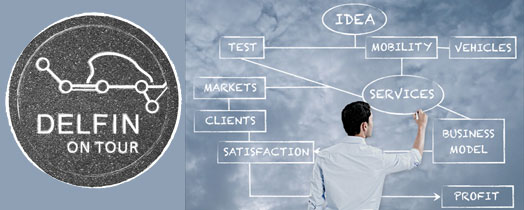Discovering electric mobility in a playful way

How can services help encourage the spread of electric mobility, and how can they be systematically developed? Using four case studies from Finland, Estonia, Denmark and Norway, Fraunhofer IAO presents various approaches to developing e-mobility projects. One of the key research findings was that using game-like methods to involve customers in the development of e-mobility projects helps those business ventures become accepted.
As part of the DELFIN research project, Fraunhofer IAO is investigating the role services play in the market penetration of electric mobility. From their results, the researchers are deriving development approaches for successful e-mobility services and methods for implementing them.
Two authors from the team have now used recently published case studies to present specific e-mobility ventures and projects and consider them from the services perspective. This allows interested parties to see how services contribute to the spread of electric mobility from a variety of viewpoints. It also gives them valuable insights into the key factors in developing successful e-mobility business ventures.
Keys to success: gamification and getting users involved at an early stage of development
In order to get business and private users excited about e-mobility projects, it is important to involve them in the development process as soon as possible. This brings companies a double benefit: it not only gives their target group a chance to express the specific requirements they have of a given service, but also binds them to the company and its business venture from the start.
However, the optimum degree of user involvement in individual development stages depends on various factors, including the nature of the target group, the maturity of the service prototype, and the project budget. “Co-design sounds exciting, and working with customers is fun – but it’s far from easy to decide how much collaboration is the right amount, or when exactly to involve them and what methods to employ,” says Sabrina Lamberth-Cocca, a scientist at Fraunhofer IAO and one of the authors.
She adds that the key is to cleverly combine strongly integrative co-design methods, surveys to gather feedback, and methods for understanding the user perspective. When determining the degree to which customers should be integrated, it is essential to consider a service’s entire development process, to vary the methods depending on the development stage, and to start integration early so that the service is fully aligned with customer requirements.
Gamification – the use of elements and processes typically found in games – could play a major role in this. Meanwhile, lab-based approaches and pilot programs are seen as ideal for the testing phase that precedes rollout in the market, although in many cases these should themselves be preceded by tests of the business model.
Science-based support for the development of e-mobility services
Fraunhofer IAO supports companies in their user-oriented development of services in a variety of fields. When it comes to the innovative field of e-mobility, our researchers are developing approaches that are aligned with the sector’s special requirements and selecting methods that are appropriate to those approaches.
The publication discussed above is entitled “Success with electric mobility – case studies of user-friendly services and innovative business models” and can be downloaded in English and German.
Contact:
Sabrina Lamberth-Cocca
E-Mail: sabrina.lamberth-cocca@iao.fraunhofer.de
Phone: +49 711 970-5137
https://www.iao.fraunhofer.de/lang-en/about-us/press-and-media/1274-discovering-…
http://www.elektromobilitaet-dienstleistungen.de/?p=3007
https://shop.iao.fraunhofer.de
http://www.elektromobilitaet-dienstleistungen.de/?p=3113
Media Contact
All latest news from the category: Transportation and Logistics
This field deals with all spatial and time-related activities involved in bridging the gap between goods and people, including their restructuring. This begins with the supplier and follows each stage of the operational value chain to product delivery and concludes with product disposal and recycling.
innovations-report provides informative reports and articles on such topics as traffic telematics, toll collection, traffic management systems, route planning, high-speed rail (Transrapid), traffic infrastructures, air safety, transport technologies, transport logistics, production logistics and mobility.
Newest articles

Superradiant atoms could push the boundaries of how precisely time can be measured
Superradiant atoms can help us measure time more precisely than ever. In a new study, researchers from the University of Copenhagen present a new method for measuring the time interval,…

Ion thermoelectric conversion devices for near room temperature
The electrode sheet of the thermoelectric device consists of ionic hydrogel, which is sandwiched between the electrodes to form, and the Prussian blue on the electrode undergoes a redox reaction…

Zap Energy achieves 37-million-degree temperatures in a compact device
New publication reports record electron temperatures for a small-scale, sheared-flow-stabilized Z-pinch fusion device. In the nine decades since humans first produced fusion reactions, only a few fusion technologies have demonstrated…





















